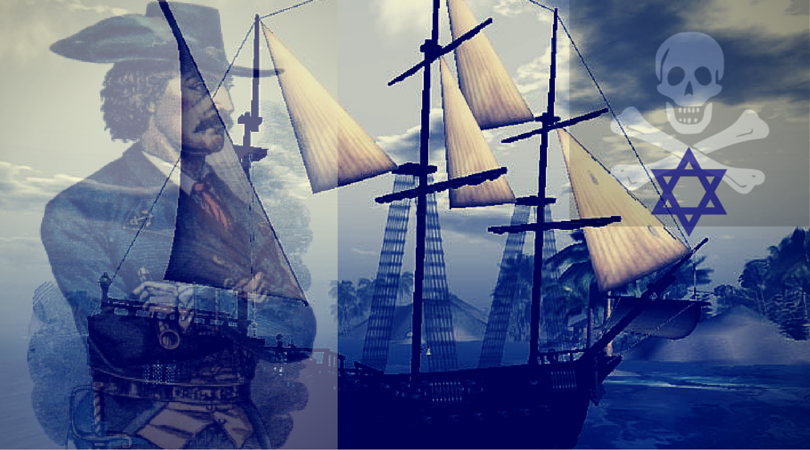Revenge was sweet. In the centuries following the Spanish and Portuguese Inquisitions of the Holy Roman Empire, there were Jews that took to the high seas to punish with vengeance those that had betrayed them and their families.
Sinan Reis (Ciphat Sinan) – known as the Great Jew – was one such avenger. After being forced out of Spain, his family relocated to Smyrna,Turkey, his birthplace. As a young man carrying the wounded pride of his displaced family, Ciphut Sinan joined forces with the Ottoman Empire and with Barbary Coast buccaneers that savaged the navies of Spain’s Charles I, the Holy Roman Emperor. Endearing himself to the famous Ottoman admiral Barbarossa, Sinao O Judeo, as the Portuguese called him, led the Ottoman’s to victory over the Spanish through cunning and often brilliant military strategy. When operating out of Algiers in 1538, Sinan destroyed most of Spain’s naval fleet off the port of Pleveza, in Greece. Significantly, Ciphut Sinan led his ship under the flag of the Seal of Solomon, similar in appearance to the Star of David.
The Great Jew was to be properly rewarded by Barbarossa for his efforts. In 1540, Emperor Charles’ forces captured Sinan’s son and had him baptized by the Lord of Elba. Barbarossa would have none of that, and after several failed negotiations for the boy’s release, landed his forces at Piombino, he ransacked the town and blew up the fort. At the time of his son’s release by the beleaguered Holy Roman Emperor enemy, Sinan was in the Suez on the Red Sea, preparing an Indian force to attack the Portuguese.
Decades later, brothers Abraham and Moses Cohen Henriques, of Portuguese Sephardic origin, would rule the high seas of the Caribbean and later the Brazilian coast. Moses Cohen would fearlessly capture over 500 Iberian ships; during the Eighty Years War, the Dutch fight for autonomy from Phillip II of Spain, the brothers came to the aid of the Dutch West Indies Company in one of the greatest heists in history, capturing the Spanish treasure fleet in the Battle of the Bay of Mantazas, in Cuba. Moses Cohen Henriques, perhaps the most famous Jewish pirate in history, eventually went on to establish his own pirate island off the coast of Brazil.
The strange case of Yaakov Koriel betrays the confusion that reigned during the Inquistion, when Jewish families were ripped apart, some accepting Christianity in the full, others taking their beliefs underground to live outwardly as Christians, but secretly as Jews; the latter were known as Marranos, Conversos, or in Hebrew, Anusim.
Koriel was a Marrano that had sailed with the Spanish Fleet until his true identity was revealed. As a captive of the Holy Roman Empire, he was secretly shown a route to escape by his fellow sailors, many of whom were Marranos as well.
After that, revenge on the Spanish became his sole purpose in life. Fleeing to the Caribbean, he eventually commanded three pirate ships that would incessantly attack the Spanish Fleet marauders that robbed the locals of their gold and silver riches. Many of the pirates that served Koriel were openly religious Jews seeking to avenge the humiliation and suffering at the hands of the Spanish Inquisitors. Ironically, one of Koriel’s brothers, Francisco, became a Catholic Inquisitor himself, later taking the role of the first Archbishop of Mexico.
Years later, Koriel would make a full return to his Judaism, abandoning piracy and traveling to the Land of Israel, to the Galilean hills of Safed. There, in the serene beauty of the pastoral settings, so different from the incessant warring on the seas of the Bermuda Triangle, he became a student of Rabbi Hayim Vital, the foremost student of the Holy Ari, founder of the most prominent Kabbalistic school in Judaism.

Skull and crossbones on a Jewish pirate’s grave
Koriel was buried near his masters in Safed, while many of his cronies that fought with him as pirates avenging their heritage, were buried with a skull and crossbones on their tombs in the Portuguese Jewish Cemetery in Ouderkerk, near Amsterdam. Many prominent Sephardic Jews are buried in this cemetery, not only pirates. Among the interred are Rabbi Menasseh Ben Israel, Con Samuel Palache (famous more for his diplomacy than for his short exploits as a pirate) and the renegade philosopher Baruch Spinoza .
As it seems, the appearance of the skull and crossbones on these Jewish graves is not meant in any way to be a mark of derision, but rather a mark of pride – Jewish pride; Jewish pride and Jewish revenge of the brutal and often sadistic Inquisitors that visited upon the Jews and all “infidels” the wrath of their fury.
Thus, this is a sadly forgotten story of Jewish patriotism. As it seems, most of the monies wrested from the Spanish and Portuguese was taken by those that were aided by the Jewish pirates, be it the Ottomans or the Dutch. For the Jews, revenge was sweet enough.

